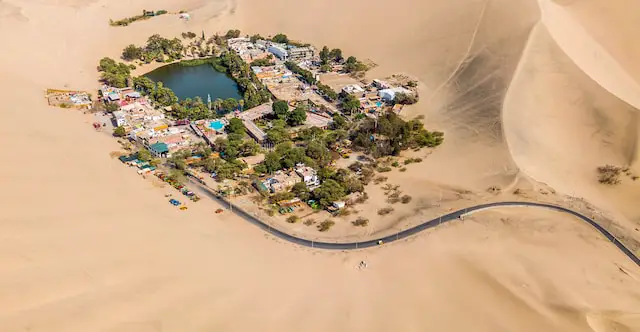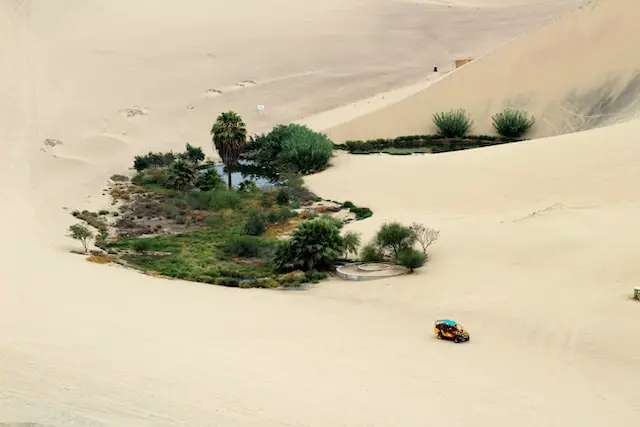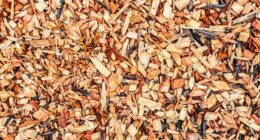Both oasis and a wadi are unique natural wonders that can be found in arid regions around the world, they differ significantly from each other. Oases are verdant patches of land surrounded by deserts or dry areas that provide a fertile environment for plant life to thrive. On the other hand, wadis are typically dry riverbeds that only fill with water during certain seasons of the year.
What is an oasis?
(Photo by Willian Justen de Vasconcellos on Unsplash )

An oasis is a fertile area in the midst of a desert or arid region, where water and vegetation are present. Oases can be natural or human-made, and they have served as vital sources of life for centuries.
Natural oases form when underground rivers or springs come to the surface, providing water for plants to grow. Human-made oases are created by digging wells and channels to bring water from far distances.
Oases often appear like green islands amidst vast deserts, attracting humans and wildlife alike. They provide habitats for numerous species of animals and birds that cannot survive without access to fresh water.
In many cultures throughout history, oases have been considered sacred places because of their life-giving properties. People would gather at these sites for religious ceremonies or trading purposes.
Today, many modern cities have grown around oases as they offer valuable resources such as agriculture, tourism opportunities and oil extraction.
What is a wadi?
(Photo by Chris Linnett on Unsplash )

A wadi is a dry riverbed, or sometimes a valley, that only contains water during periods of heavy rainfall. These temporary rivers can be found in arid regions around the world and are vital sources of water for both humans and wildlife when they do contain water.
Wadis can vary greatly in size and shape, from narrow channels to wide valleys. They often have steep sides and rocky bottoms which make them difficult to traverse on foot or even by vehicle.
During times of drought, wadis may remain completely dry for years on end. However, during wetter periods they can quickly become raging torrents capable of causing flash floods that can be extremely dangerous to anyone caught within their path.
Despite their unpredictable nature, wadis are important ecosystems that support a variety of plant and animal life throughout the year. In some cases, they also provide valuable routes for transportation through otherwise inhospitable terrain.
Wadis are fascinating natural formations that showcase the power and unpredictability of our planet’s weather systems.
Oasis Vs. Wadi – Key differences
When it comes to desert landscapes, both oases and wadis are important geographical features, but they differ in their formation, location and purpose. An oasis is a fertile spot in a desert where water is present at or near the surface of the ground. It typically consists of palm trees, other vegetation and often human settlements. A wadi, on the other hand, is a dry riverbed that only carries water during times of heavy rain or flash floods.
One key difference between oases and wadis lies in their source of water supply. Oases usually rely on underground springs or wells for their freshwater needs while wadis depend on seasonal rainfall which quickly evaporates from the rocky terrain.
Another notable distinction between oases and wadis relates to their physical appearance. Oases tend to be verdant green areas surrounded by dunes while wadis appear as deep valleys with steep walls carved out by erosion over time.
Additionally, oases serve as vital habitats for wildlife such as birds and mammals while also providing shelter for nomadic tribes who use them as pastoral lands for grazing livestock. By contrast, Wadis have little vegetation cover except some hardy shrubs that can withstand hot temperatures making it difficult to support any kind of ecosystem.
Understanding these differences helps us appreciate how these two natural wonders shape the environment around them differently. Whether you prefer lush vegetation or rock formations sculpted by nature’s forces – there’s something awe-inspiring about both oases and wadis!
How to find an oasis or a wadi
If you’re an adventurer or traveler looking to explore the desert, finding an oasis or a wadi can be quite exciting. But how do you find them? Here are some tips on how to locate these natural wonders.
Firstly, research is key. Look up maps and guides that highlight potential areas where oases or wadis might be found. This will give you a good starting point for your search.
Once in the desert, keep your eyes peeled for any greenery or vegetation as this could indicate water sources nearby. Also, look out for signs of animal life such as birds and insects which may lead you towards water.
Another way to find an oasis is by following dry riverbeds called “wadis”. These channels once flowed with water during heavy rainfall but have since dried up leaving behind fertile soil which attracts plant growth and wildlife.
Ask locals if they know of any oases or wadis in the area. They may have valuable knowledge about hidden gems that aren’t always documented in guide books.
Remember though, locating these treasures requires patience and perseverance so don’t get discouraged if it takes time. The journey itself can also be rewarding so enjoy the experience!
What is the biggest oasis in the world?
When we think of an oasis, the first thing that comes to mind is a small patch of green amidst vast deserts. However, did you know that the biggest oasis in the world covers an area of over 1200 square miles? That’s right; it’s the Al-Hasa Oasis located in Saudi Arabia.
The Al-Hasa Oasis is home to more than three million palm trees and countless other plants. It is situated between two major cities – Dammam and Hofuf – which makes it easily accessible for visitors who want to witness its beauty firsthand.
Apart from being visually stunning, this oasis has significant historical value as well. It dates back more than 5000 years and was once an important trade route between Mesopotamia and India.
If you plan on visiting this incredible site, there are various things to do when exploring Al-Hasa. You can take a leisurely walk through its numerous gardens or visit one of many museums located within its boundaries.
While many people may not know about the largest oasis globally, it still remains one of Saudi Arabia’s most prized possessions. Its size alone makes it worth experiencing for anyone looking to explore something unique during their travels.
How is a wadi formed?
Wadis are dry riverbeds that only flow with water during and after heavy rainfall. These geological formations are typically found in arid regions, which receive limited rainfall throughout the year. A wadi is formed when rainwater flows through a narrow channel or canyon, eroding the soil and rock along its path.
As water from heavy rainfall flows through these channels, it carries sediment and rocks with it. Over time, this erosion deepens the channel of the wadi until it becomes a permanent feature in the landscape.
During periods of drought or low rainfall, wadis can remain completely dry for months or even years at a time. However, when storms bring heavy rains to an area, wadis can quickly fill with rushing water that can be dangerous to those caught within their path.
In addition to providing vital drainage during times of high precipitation events, wadis also serve as important ecological hotspots for many species of plants and animals adapted to living in arid environments.
Understanding how a wadi forms is essential for anyone traveling through desert regions since these geological features can provide unique opportunities for exploration while also posing significant risks if one is not careful around them during flash flooding events.
Featured Image By – Sandra Gabriel on Unsplash








